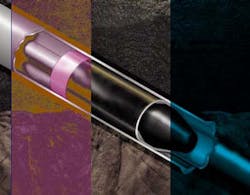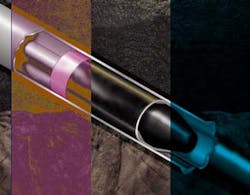EXPANDABLES TECHNOLOGY: Expandables market changing the way wells are drilled and completed
As a number of companies begin to commercialize their own line of expand- ables technology, what Shell Technology Ventures first envisioned as a smooth transition from discrete markets to global competition in expandables has clearly taken on a life of its own.
Niches are developing that allow competing technologies to emerge and flourish. Earlier this year, Shell and Baker Oil Tools (BOT) agreed to part company on the E2Tech joint venture, with Shell agreeing to buy the joint venture (JV) company. The JV has a license agreement to apply Shell's expandable tubular technology outside the US, competing with Enventure, a joint-venture Shell established with Halliburton to market the same technology in the US.
BOT recently announced its own full line of expandable tubulars designed to compete in a market that continues to grow. The firm plans to participate in all aspects of expandables, including the solid tubular, liner hanger, and sandscreen markets. Brent Emerson, Product Line Director for Well Bore Construction at BOT, claimed the company's patented applications of this technology could lead to a paradigm shift in how the industry drills and completes wells.
Some of the significant opportunities lie in difficult wells such as those encountered in deepwater. However, industry acceptance in these high cost/high risk environments can be limiting. One thing that may help speed this adaptation is a wide range of product offerings from various service companies, Emerson said.
Patenting applications
The way the new BOT expandable technology is protected is worth noting. Emerson said BOT has patented applications of expandables and acquired certain international patent rights to expandable tubular technology. This technology will be, and has been, used on the company's expandable liner hangers, solid tubulars, and expandable sandscreen systems.
Emerson said BOT has acquired technology and international patent rights to a method for expanding tubulars, called FormLocktrademark. BOT added FormLock technology to systems that the company developed internally to offer a line of products. The company proved up these products in its own test wells.
The first commercial application of the sandscreens will take place soon, as will the first run of the expandable liner hanger. The first commercial run of the company's solid expandables will accompany the sandscreen application. This offshore well will also feature the company's solid expandable packers, used to isolate zones in the open hole. This packer line, called the XL Pactrademark, works in concert with the expandable sand screens to isolate different zones in one wellbore.
The XL Pactrademark redirects flow through the sandscreen to eliminate the threat of hot spots developing in open hole production zones. These hot spot pose a threat in that they could erode the screens.
While all of these applications are coming to light quickly, it is worth noting that they are also, with the exception of the expandable liner hanger, on offshore wells. This is unusual in that, typically, new technology such as this would be applied to onshore wells first, where there are fewer environmental and logistical factors to consider.
Target markets
Emerson declined to go into detail on how the company's expansion technology operates. He did say that the solid tubulars are expanded with a cone in a top down methodology. So far, the company has successfully tested these systems in their own test wells. Emerson said the technology can successfully expand tubulars in various percentages. BOT plans to develop expandable solids in different sizes once it identifies a business case that justifies each of the new sizes.
The firm is targeting specific sectors of the overall market with this new technology. Emerson gave the example of the "cladding" market, which is a good entry-level technology in the expandables market. "Cladding helps you get your foot in the door. It helps you get the experience," he said.
Cladding is a method of tubular rehabilitation. A liner, made of expandable solids, is lowered into place and expanded inside the damaged pipe. The expansion "clads" the two pipes into one, giving the well a new liner that has minimal reduction in the internal diameter (ID) the original, damaged pipe.
This is a good entry-level application, because it typically involves a well where problems exist. That means the risk of trying the new technology is minimized, while the benefits of the cladding offer a high return. This is a way to build experience in the expandables market, he said. Experience is important in an industry that is slow to adopt new technology. The technology itself is currently viable, but Emerson predicts it will take the industry several years to embrace it.
Going forward
Emerson said he sees 2002 as a significant year for expandables in general. This will be the time when several new applications will come on line. Still, he said, it is not just the technology, but also the industry uptake that is critical. That means it will be several years, Emerson predicts, before the application of expandables reaches its potential.
One thing spurring this on is the cost driver. There are significant plays in deepwater that cannot be economically produced using conventional technology. To reach these targets, deep below the mudline, will require expandables. The payoff could be substantial in that many of these are very large fields.
Beyond that, expandables will allow operators to produce wells more efficiently. The technology allows the drilling of a smaller hole to produce through a larger completion ID.

